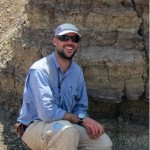Thanks to Ross Mounce for alerting me to this piece of news.
Fossil Record: An International Journal of Geosciences
We invite you to submit or recommend papers to this ISI-listed, international palaeontological journal of the Museum fur Naturkunde Berlin. Fossil Record publishes original research papers covering all areas of palaeontology and provides a platform for a wide array of articles with palaeobiological content, ranging from new descriptions of fossil faunas and floras to phylogenetic studies, palaeobiogeographic analyses and constructional morphology. All taxonomic groups of fossil organisms are considered, including invertebrates, microfossils, plants and vertebrates. Manuscripts submitted to Fossil Record will be peer-reviewed by at least two external referees. For us, the most important aspect is that Fossil Record will in 2014 become an open access journal with our new professional publishing partner Copernicus Publications. With this decision, the Museum fur Naturkunde and the team of editors close the gap between the requirements of many scientists, funders, and libraries for open access to scientific publications. As well as enjoying better visibility, your papers will be much more widely distributed and available for scientific databases. Fossil Record will have to introduce article processing charges (APC) by 2014 because open access publishing requires paying the costs of the review process, typesetting, web publication and long term archiving upon publication. APC are obtained on a page-by-page basis (please find more APC information) but many universities, research institutions and grant agencies provide funds to support authors regarding APC. Please check with your institution. In addition, Copernicus Publications has several agreements in place to settle payments directly between the respective institution and the publisher. Furthermore, Fossil Record has a budget of free pages to be decided by the Editor-in-Chief available to authors from developing countries, or for special publications upon request. We look forwards to receiving your manuscripts which can be uploaded here in the Copernicus Office Editor.
Yours sincerely, The Fossil Record Editors M. Aberhan, D. Korn, F. Witzmann
So as an open access advocate, a supporter of the EGU and Copernicus, and a palaeontologist (in case you hadn’t got that yet), it’s great to see this move from a non-OA domain within Wiley (a partial open access publisher). Also nice to see is the assistance offered to authors from developing countries, and a page-based article processing charge (APC), which may encourage different length manuscripts to be submitted. It is worth noting though that often the review process is handled by volunteer editors and volunteer reviewers, so I’m not sure why this is being included in the APC overview. Anyway, it’s a good move, and happily coincides with the EGU rolling out their altmetrics platform (altmetrics are ways of seeing how an article has been digitally disseminated, along with citation counts etc) –
great stuff!
For more on open access and stuff, I wrote a guest post for Matt Shipman on it recently, which you can find
here.


